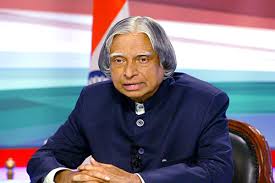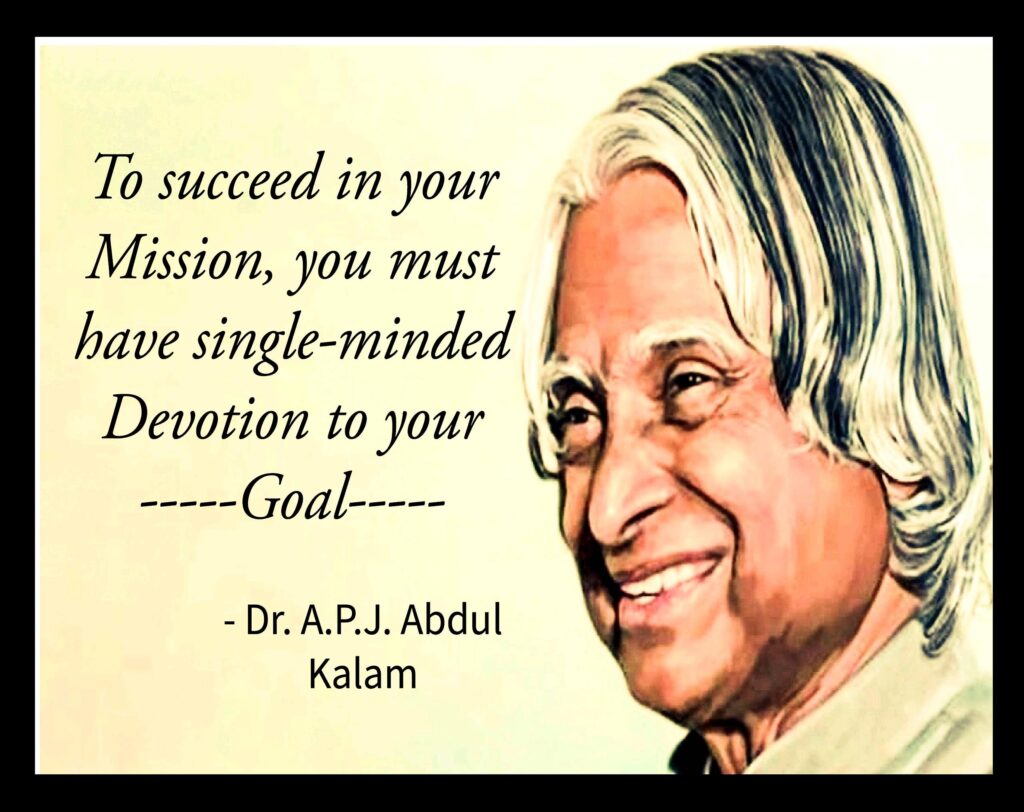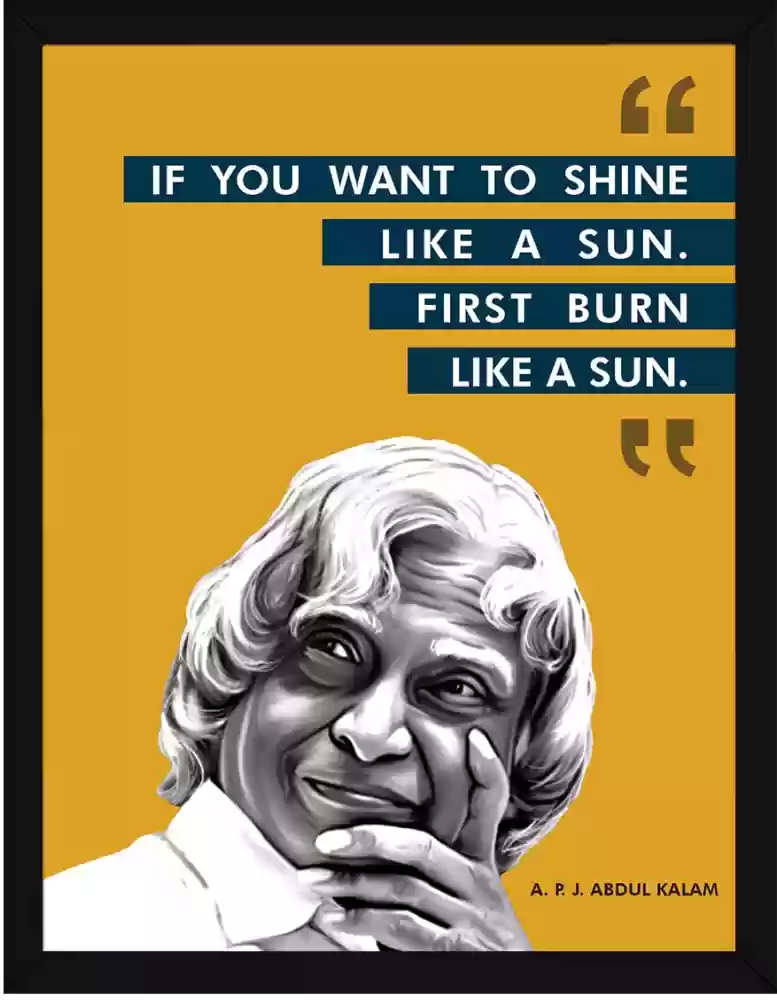
"Dream is not that which you see while sleeping, it is something that does not let you sleep."
A.P.J. Abdul Kalam
“Dream, dream, dream. Dreams transform into thoughts and thoughts result in action.” – A P J Abdul Kalam

- Avul Pakir Jainulabdeen Abdul Kalam was born to Jainulabdeen, a boat owner and Imam, and Ashiamma, a housewife. Kalam had four brothers and a sister, all elder to him.
- Although Kalam’s ancestors had been wealthy traders, the family had descended into difficult times and Kalam used to sell newspapers as a child to add-on to his family’s modest income.
- Kalam studied at a school in Ramanathapuram and acquired a degree in Physics from Saint Joseph’s College, Tiruchirappalli. In 1955, he went to the Madras Institute of Technology to pursue aerospace engineering. His dream of becoming a fighter pilot was thwarted when he missed the qualifier by a narrow margin. He was ranked ninth but only 8 positions were available with the IAF.
- After that, he got a job as a scientist at the Aeronautical Development Establishment of the Defence Research and Development Organisation (DRDO). He also worked under eminent scientist Vikram Sarabhai.
- Kalam was transferred to the Indian Space Research Organisation (ISRO) in 1969. At ISRO, he was the Project Director of the satellite launch vehicle (SLV) that successfully deployed the satellite Rohini into orbit in 1980. It was India’s first SLV.
- Kalam also worked to develop the Polar Satellite Launch Vehicle (PSLV).
- He was also the director of two projects, Project Valiant and Project Devil for developing ballistic missiles from the SLV technology. His research and leadership led him to the directorship of an advanced missile development programme.
- When R Venkataraman was the Defence Minister, Kalam was appointed the chief executive of the Integrated Guided Missile Development Programme that was a project aimed at developing a fleet of missiles.
- He was known as the ‘Missile Man of India’ for his work in the development of ballistic missile technology.
- From 1992 to 1999, Kalam was the Chief Scientific Adviser to the Prime Minister and the Secretary of the DRDO. Kalam was the Chief Project Coordinator during the Pokhran II tests. During this time, Kalam became India’s best-known scientist.
- In 2002, Abdul Kalam was elected the 11th President of India. He had won by a huge margin. He was the first scientist to become India’s President and incidentally the first bachelor too.
- Kalam’s term as the president which lasted the full term till 2007 was beneficial for the office of the president itself. He came to be called the People’s President. His popularity soared among the people, especially school children. He visited many parts of the country and his speeches became popular for their motivational content.
- Despite pressure from the people to have him stand for a second term, he decided not to contest.
- After the presidency, Kalam became a visiting professor at the IIM Ahmedabad, IIM Shillong, IIM Indore, the Indian Institute of Science, Bangalore, Anna University, etc.
- Abdul Kalam died of a cardiac arrest while giving a lecture at the IIM Shillong on 27 July 2015. There was widespread grief expressed at his passing away with the government of India declaring a 7-day state mourning. The governments of various other countries as well as the United Nations expressed their grief.
- He was laid to rest with full state honours at his native Rameswaram.
- Abdul Kalam was a man of integrity who was known for his honesty. He left no personal wealth after his death barring a few personal possessions which included his books, laptop, etc.
- He was knowledgeable in the teachings of various religions and had become a symbol of inter-faith dialogue.
Awards and Honours won by APJ Abdul Kalam
There are a few awards and honours won by APJ Abdul Kalam:
| Year of Award | Award/Honours |
| 1981 | Padma Bhushan |
| 1990 | Padma Vibhushan |
| 1997 | Bharat Ratna |
| 1997 | Indira Gandhi Award for National Integration |
| 1998 | Veer Savarkar Award |
| 2007 | King Charles II Medal (Royal Society, UK) |
| 2014 | Doctor of Science (Edinburgh University, UK) |
On this day of History(15 October)
There are a few other events that took place on the same date as that of the birth of APJ Abdul Kalam.
- 1542: Birth of Mughal Emperor Akbar at Amarkot, Sindh
- 1676: East India Company permitted by the monarch of England to mint rupee and paisa coins at Bombay.
- 1918: Death of Sai Baba of Shirdi.
- 1932: The first Indian commercial airliner Tata Sons Ltd. started.
- 1943: Death of poet and freedom fighter Baba Kanshi Ram.
- 1990: Nelson Mandela awarded the Bharat Ratna.
- 1997: Arundhati Roy received the Booker Prize.
About
- Dr. A.P.J. Abdul Kalam, a distinguished scientist and former President, was born on October 15, 1931, in Tamil Nadu.
- In honor of his dedication to students and his commitment to shaping the next generation, his birth anniversary is celebrated as World Students’ Day.
- Dr. Kalam, often referred to as the ‘Missile Man of India’, played a crucial role in advancing the country’s space and defence programs as a scientist.
Furthermore, his lasting legacy as an educator, author, and visionary President has made significant contributions to the development of the nation.

Glimpse of Dr. Kalam Life
- Kalam, a recipient of the Bharat Ratna award, was born in Rameswaram, Tamil Nadu.
- Throughout his career, Kalam held prominent positions as an administrator in the Defence Research and Development Organization (DRDO) and the Indian Space Research Organization (ISRO).
- In 2002, this esteemed aerospace scientist became the 11th President of India, serving in office until 2007. Following his presidency, he continued to devote himself to teaching.
- He took on roles as a visiting professor at the Indian Institute of Management (IIM) in Ahmedabad, IIM Shillong, and IIM-Indore.
- For his contributions as a scientific advisor to the government of India, Kalam was honoured with the Padma Vibhushan and the Padma Bhushan awards.
- Nevertheless, the significant contributions of Dr. A. P. J. Abdul Kalam to scientific and technological advancements in the country are still remembered today.
Some Fact about A.P.J. Abdul Kalam
- Dr. Kalam was awarded the Doctor of Science degree by 28 universities. He has received several awards including the National Design Award, Dr. Biren Roy Space Award, Professor Y Nayudhamma Memorial Gold Medal (1996), GM Modi Science Award (1996), R K Firodia Award for Excellence in Science and Technology (1996), Veer Shavalkar Award (1998), For National Integration Indira Gandhi Award (1997).
- He is a member of numerous professional societies including Aeronautical Society of India, Astronautical Society, and Aeronautical Society of India, Indian National Academy of Engineering, Indian Academy of Sciences and Institute of Electronics and Telecommunications Engineers.
- He is also the author of many books – India 2020: A Vision for the New Millennium, Wings of Fire: An Autobiography, and Ignited Minds-Unleashing the Power within India etc.
Contributions of Dr. A.P.J. Abdul Kalam: In Space, Engineering and Medicine
India’s first Indigenous Hovercraft
- Dr. Kalam and his team developed Nandi, India’s Indigenous hovercraft, symbolizing strength and innovation.
India’s first Satellite Launch Vehicle
- As project Director of ISRO, Dr. Kalam led the development of SLV III, successfully launching the Rohini satellite in 1980.
INCOSPAR committee
- Dr. Kalam was part of the committee that established TERLS, Thumba Equatorial Rocket Launching Station, for space research.
Ballistic Missile Project
- Leading DRDO, Dr. Kalam developed indigenous guided missiles like Agni and Prithvi based on the SLV Program.
Chief Scientific Advisor and DRDO Secretary
- He served as a Chief scientific advisor to the government of India coordinating the Pokhran II nuclear test.
Launch Vehicle
- Dr. Kalam promoted and backed the advancement of different satellite launch vehicles, such as the Polar Satellite Launch Vehicle (PSLV) and the Geosynchronous Satellite Launch Vehicle (GSLV).
Integrated Guided Missile Development Program
- Dr. Kalam at DRDO implemented this program which advanced India’s missile technology, as a result he was named as ‘Missile Man of India’.
Kalam- Raju Stent (Universal Healthcare Plan)
- Dr. Kalam and D. Soma Raju collaborated to develop a coronary stent ‘Kalam-Raju Stent‘ to make healthcare accessible to all.
Kalam Raju Tablet
- Dr. Kalam and Dr. Soma Raju, came up with a rough tablet computer to take care of the health of underprivileged people of rural India.
PURA – Provision of Urban Amenities to Rural Areas
- Dr. Kalam gives the strategy for rural development in India as discussed in his book Target 3 Billion. It proposes that urban infrastructure and services be provided in rural hubs to create economic opportunities outside of cities.
An Innovator in Fiberglass Technology
- He played a pioneering role in the field of fiberglass technology and guided a team of young individuals to embark on this endeavour at ISRO. Their work encompassed the entire process, starting from designing and developing composite rocket motor cases, all the way to their production.
Technology Vision 2020
- In 1998, a comprehensive plan named Technology Vision 2020 was proposed.
- Its objective was to outline a roadmap for India’s transformation from a less-developed nation to a developed society within a span of 20 years.
- The plan aimed to achieve this by implementing various measures, including enhancing agricultural productivity, promoting technology as a catalyst for economic growth, and improving accessibility to healthcare and education.
Dr. Kalam talked of ‘Creating a Liveable Earth’ – In Last Speech
- “Sustainable development enables the realisation of green clean environment without pollution, having prosperity without poverty, peace without fear of war and a happy place to live for all citizens of the nation of the world.”
- In this last speech, Dr. A.P.J. Abdul Kalam laid the blueprint of his ‘World vision 2030 of a liveable planet earth’.
Thus, despite the accomplishments and contributions of Dr. A.P.J. Abdul Kalam, he always wished to be recognized as a teacher. He breathed his last on July 27, 2015, and collapsed while delivering a lecture at IIM-Shillong and died from a cardiac arrest. Thus, his his contributions are still remembered as some of the scientific and technological developments in the country.
Some great thoughts of Abdul Kalam






